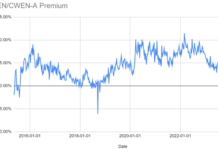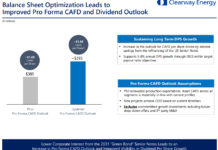Tom Konrad CFA
![]()
Disclosure: Long BEP, HASI.
NRG Yield (NYSE:NYLD) was spun out of its parent, NRG Energy, Inc. (NYSE:NRG) in July, and has since been greeted with enthusiasm by investors. The stock priced at $22, 10% over the mid-point of its expected range, and the underwriters exercised their full over-allotment option.
NRG Yield presents itself as an owner and operator of contracted renewable and conventional electricity generation, as well as thermal infrastructure assets. (Thermal infrastructure provides heat or cooling to businesses for use in their operations.) The company has a green tinge because of its wind and solar generation, and seems to be designed to appeal to green investors who also like the green of a substantial dividend yield.
How Green Is It?

Data: NYLD SEC Filings
|
Although I manage green portfolios professionally, I was not particularly interested, mainly because the company does not seem all that green. Renewable energy only accounts for 30% of revenues, or 43% of assets and income (see chart.) This is greener than most independent power producers, but there are many income stocks with greener portfolios available.
Show Me the Green
That said, most income investors care more about the green an investment pays out in dividends than the greenery of how it makes that money. NRG Yield has yet to pay a dividend, but the most recent quarterly report states: “NRG Yield, Inc. expects to declare and pay a dividend of $0.23 per Class A common share during the fourth quarter of 2013.”
At the IPO price of $22, this would have amounted to a less than stunning 4.2%annual yield, but since then, investors have bid the stock up to $34.60, reducing the yield to 2.7%. However, analysts at Goldman Sachs expect NRG Yield to raise its dividend further. They recently issued a new price target of $41 based on a 3.5% dividend yield (corresponding to a $0.36 quarterly dividend.)
Comparables
Even the 4.2% yield offered by Goldman’s future dividend estimate at the current price of $34.60 seems low to me.
Completely green income alternatives such as Pattern Energy Group (NASD:PEGI), Brookfield Renewable Energy Partners (NYSE:BEP), and Hannon Armstrong Sustainable Infrastructure (NYSE:HASI) all compare favorably on yield. Pattern Energy owns a portfolio of wind farms, and expects to start paying a $0.3125 quarterly dividend (5.4% annual yield) in the fourth quarter, when NRG Yield will only be paying 2.7%.
Brookfield Renewable is already paying a $0.362 quarterly dividend (5.3%) and owns a portfolio of hydropower, wind, and solar generation.
Hannon Armstong’s business is less comparable, since it invests in energy efficiency projects and other sustainable infrastructure. As a REIT, dividends may be subject to higher tax rates than the other three, but its CEO has said that it will declare a dividend in excess of $0.219 for the fourth quarter (7.4%), and will eventually ramp up to $0.234, or 8% based on the current $11.76 share price. Even if we adjust Hannon Armstrong’s expected dividend down by 15% to reflect a 35% income tax rate rather than the 20% rate on qualified dividends, it’s expected yield is 6.8%, 2.6% higher than the yield Goldman is predicting for NYLD. Such an adjustment would not be necessary for an investor in a lower tax bracket or one investing through a retirement account.
Conclusion
Given the other green income options available on US exchanges (not to mention more attractive yields available in Canada,) I fail to see the attraction of NRG Yield.
Looking at recent news articles, I can only guess that investors are giving the company a “green” premium based on frequent mentions in articles about solar. That would be ironic, given that NRG Yield’s greenery is even less compelling than its yield.
This article was first published on the author’s Forbes.com blog, Green Stocks on October 23rd.
DISCLAIMER: Past performance is not a guarantee or a reliable indicator of future results. This article contains the current opinions of the author and such opinions are subject to change without notice. This article has been distributed for informational purposes only. Forecasts, estimates, and certain information contained herein should not be considered as investment advice or a recommendation of any particular security, strategy or investment product. Information contained herein has been obtained from sources believed to be reliable, but not guaranteed.








